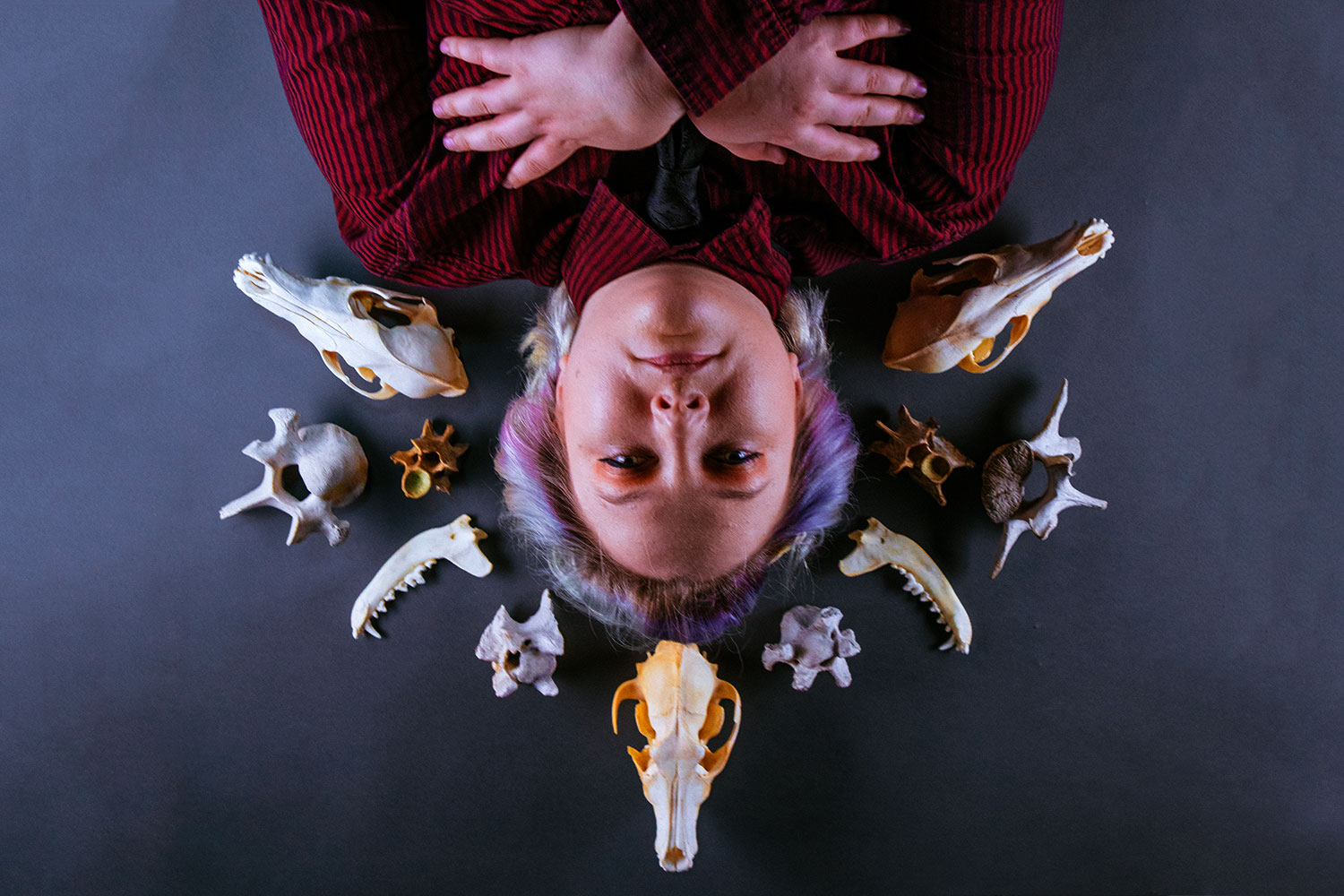Jessica Kinser was a teenager, 16 or 17, when she processed her first skull. Her parents, both avid hunters and food preppers, had harvested a deer, and young Jessica salvaged the decomposing head from the yard where she and her family lived in Springfield.
She didn’t have the money to taxidermy the thing, so she got busy self-educating, hitting up all the modern resources — Google, YouTube, the public library — in order to figure out how to de-flesh and clean the head to the whiteness she desired.
Armed by the internet with the basics of taxidermy, she first boiled the deer skull in a crockpot she borrowed from the kitchen. “I didn’t ruin the crockpot, but my mom was absolutely repulsed when she found out,” Kinser admits.
Once the skull was denuded of most of its flesh, she scrubbed it with toothpaste. “I used the hand-scrubber my mom used to clean cups,” she says, laughing.
That deer skull now hangs on the wall of her home studio in Glenwood, surrounded by an assortment of skeletal remains fashioned carefully and thoughtfully into works of art — everything from earrings made from raccoon jawbones to treated pelts and furs, to coyote skulls pinioned under a bell jar like something you might find on the bookshelf of Sherlock Holmes.
Kinser, 25, is an artist working in the realm of “vulture culture,” a term she only learned after the fact when she went online looking for her aesthetic kin. “I found out that was essentially what I was doing,” she says, describing a process that involves taking “the things that would otherwise decompose or be gone forever and making something beautiful out of them.”
For Kinser, this includes everything from “shed hunting,” or scavenging for discarded antlers and bones in the woods, to processing roadkill — but only if she can get to it fresh, before it grows too gassy with decomposition. Everything that is not protected or hunted is fair game for a vulture culturist, including farm animals and domestic pets, provided they die of natural causes.
She’s not into killing. Kinser picks up only where death leaves off.
Enlarge
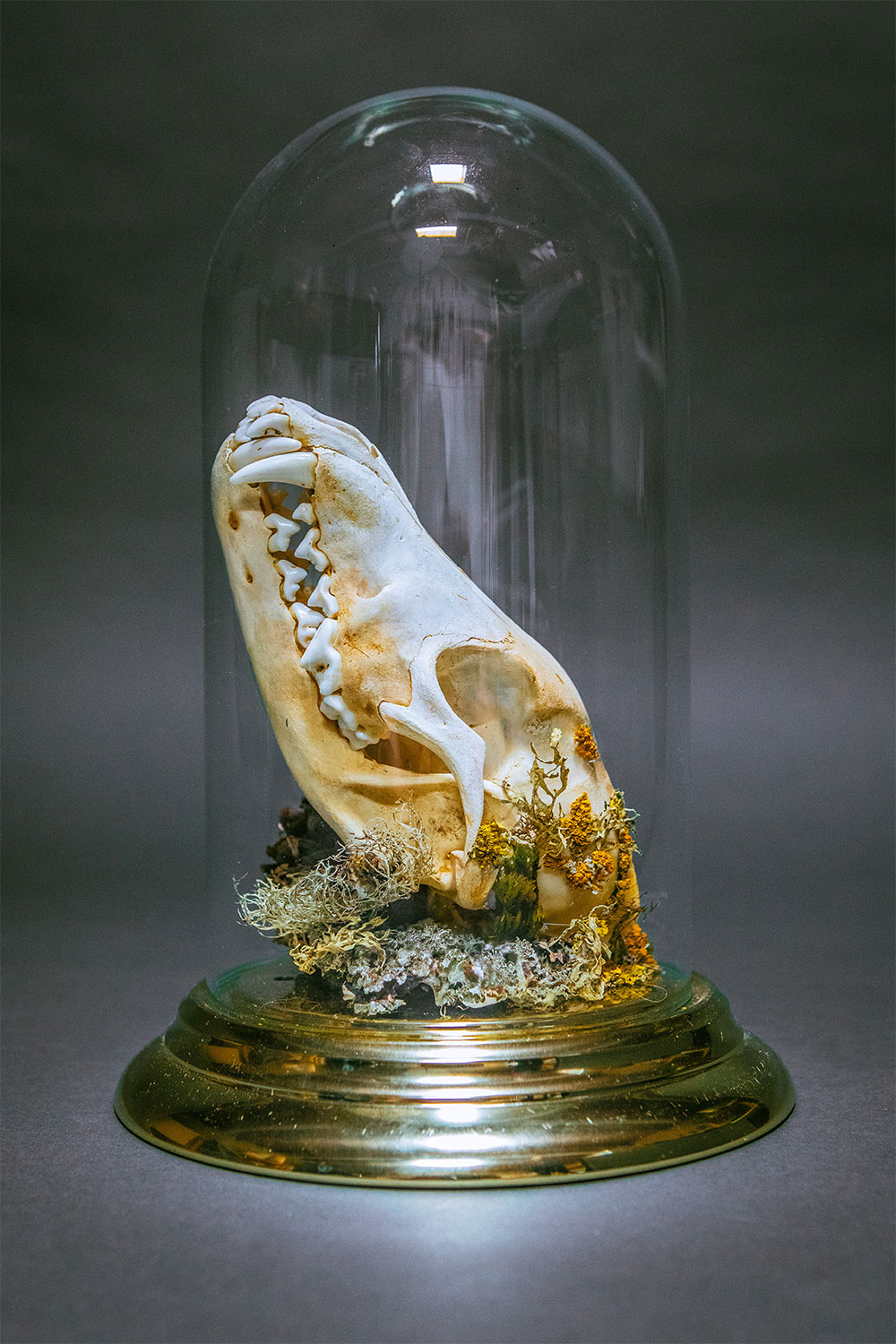
Photo by Todd Cooper
Death Be Not Strange
Death, then, figures significantly in Kinser’s art. For the philosophically minded, this amounts to a tautology; poets, after all, have been making art out of dead things for millennia — dead lovers, dead flowers, dead empires, dead ideas. All art, ticking against time and yearning for immortality, is a conversation with, or against, death. All art remembers.
But with Kinser, death not only informs her subject; it is the subject, in a way so tangible and confrontational that it defies abstraction. “It definitely challenges people to look at how they view death,” she says of her artwork, which transforms the chalky white of a bleached bone into its own complex palette.
“I don’t necessarily love death,” she continues, “but it’s the passing of energy that I’m super into. Without death there is no life. I enjoy challenging people to not make it a sad thing, but rather appreciating it as an important part in the process of life.”
I can attest, having spent some time with her, that Kinser is not in the least bit creepy or morbid or bat-cave morose, as some might suspect; in fact, she’s a rather buoyant and kind woman, the owner of a hearty belly laugh that disarms you right before it becomes contagious. Her approach to death might be fetishistic, but it is not overly romantic or twee; rather, her negotiation of her subject is principled and pragmatic, though, in its own way, it has a spiritual component.
Such an attitude derives, I believe, from two unique but mutually reinforcing aspects of Kinser’s character, and you can’t have the one without the other. Rather, it’s the interplay of both these elements that makes Kinser such a distinctly homegrown artist — a true product of Oregon’s strange and storied frontier heritage.
The first aspect is her childhood — a youthful environment that should sound familiar to anyone raised in even modest contact with the rural or semi-rural Northwest. She describes her upbringing as “relaxed conservative,” meaning that her parents “are pretty accepting of most things, but they definitely have very blue-collar, traditional values.”
Educated, working-class and artistically inclined, her parents are also bow hunters who took to processing their own food, instilling in their daughter the homesteading values of frugality, conservation and self-reliance. Such woodsy naturalism, combined with the spirit of westward-ho individualism, is what gives states like Washington and Oregon their strong libertarian strain. Minus our urban centers, we are the Appalachia of the North.
What this meant for Kinser was that, as a child growing up in Springfield (aka “Springtucky”), she was in constant contact with the cycles of nature and the backwoods rigors of hunting and gathering — the skinning, butchering and processing of food — while also attending public schools in a moderately sized, moderately modern city. Artists often spring forth where cultures collide.
The other aspect of Kinser’s personality that feeds and fuels her art, then, might be considered her introduction to art, which led to a confrontation with her own outsider status. As a student at Briggs Middle School, she was enrolled in an A3 high school pilot program, VADA (Visual and Dramatic Arts), which sought to discover whether “students who are creatively inclined would thrive if given the space to be creative.”
Being sequestered in this program during her formative years in middle school fostered in Kinser a love for the arts and hands-on learning, so much so that when she moved on to being a part of the general population at Springfield High School, “it was brutal… that was kind of the start of knowing that I’m much more artistic. I would go insane if I had zero creative outlet.”
After graduating high school, Kinser attended Lane Community College, where she enrolled in a figure drawing class with Eugene painter Adam Grosowsky. “He pushed me to get into painting, and within the next two months I was painting these big, huge paintings,” she recalls.
I’ve seen her paintings and they are stunning. One of them, an impressionistic portrait of a raven hanging on her studio wall, is rendered with a smudgy, sinister beauty that recalls the work of Ralph Steadman and Francis Bacon. Kinser told me she finished it in about half an hour.
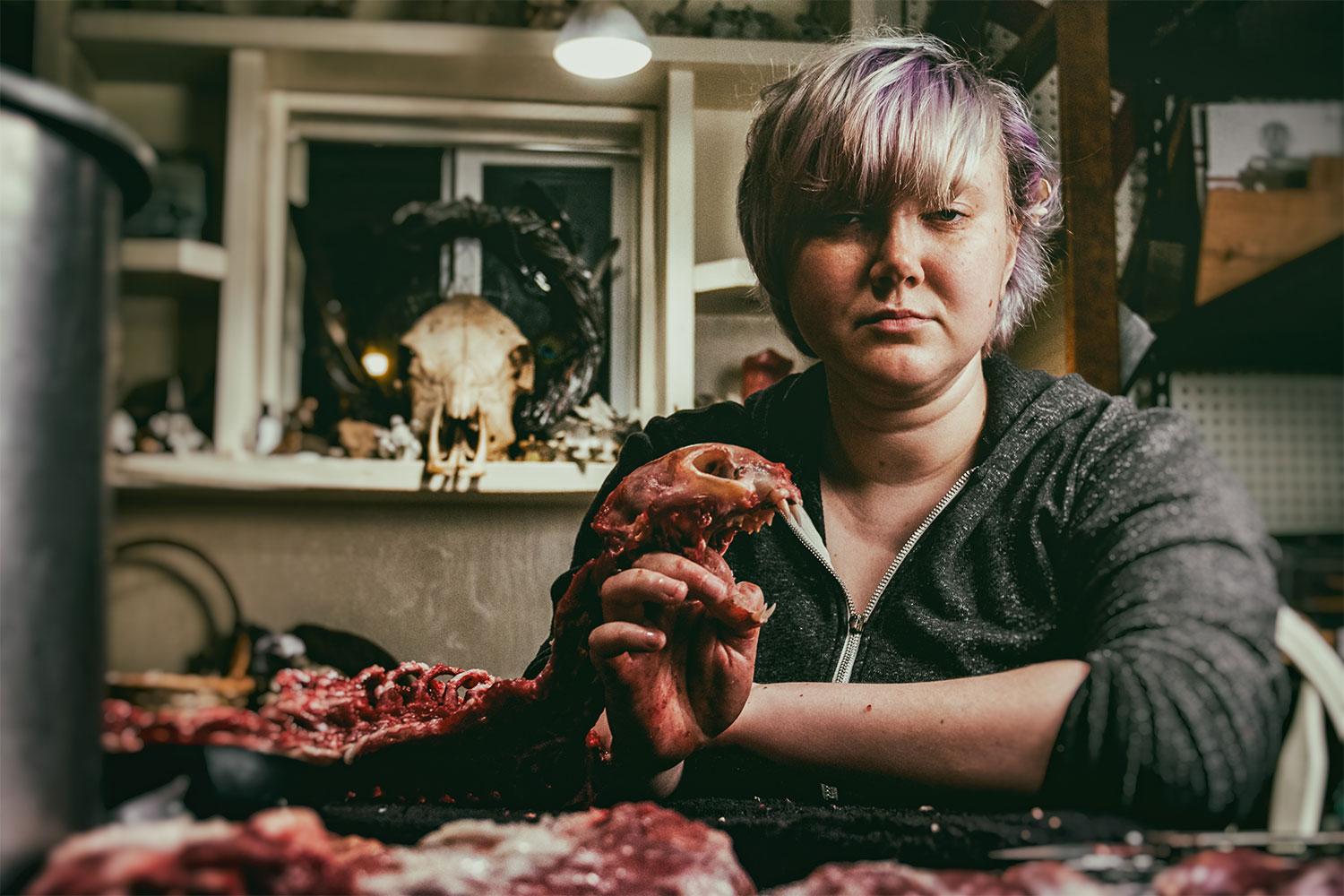
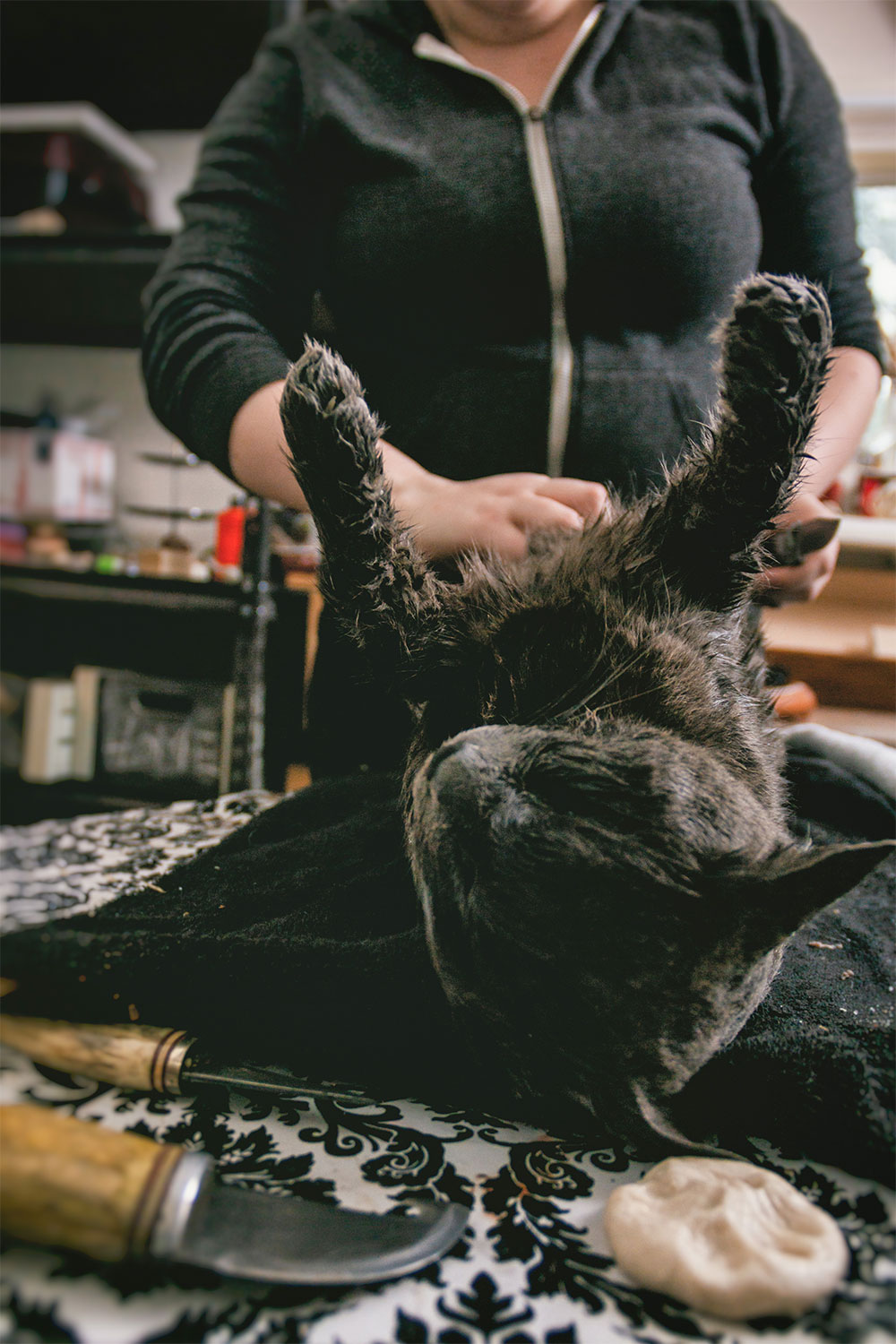
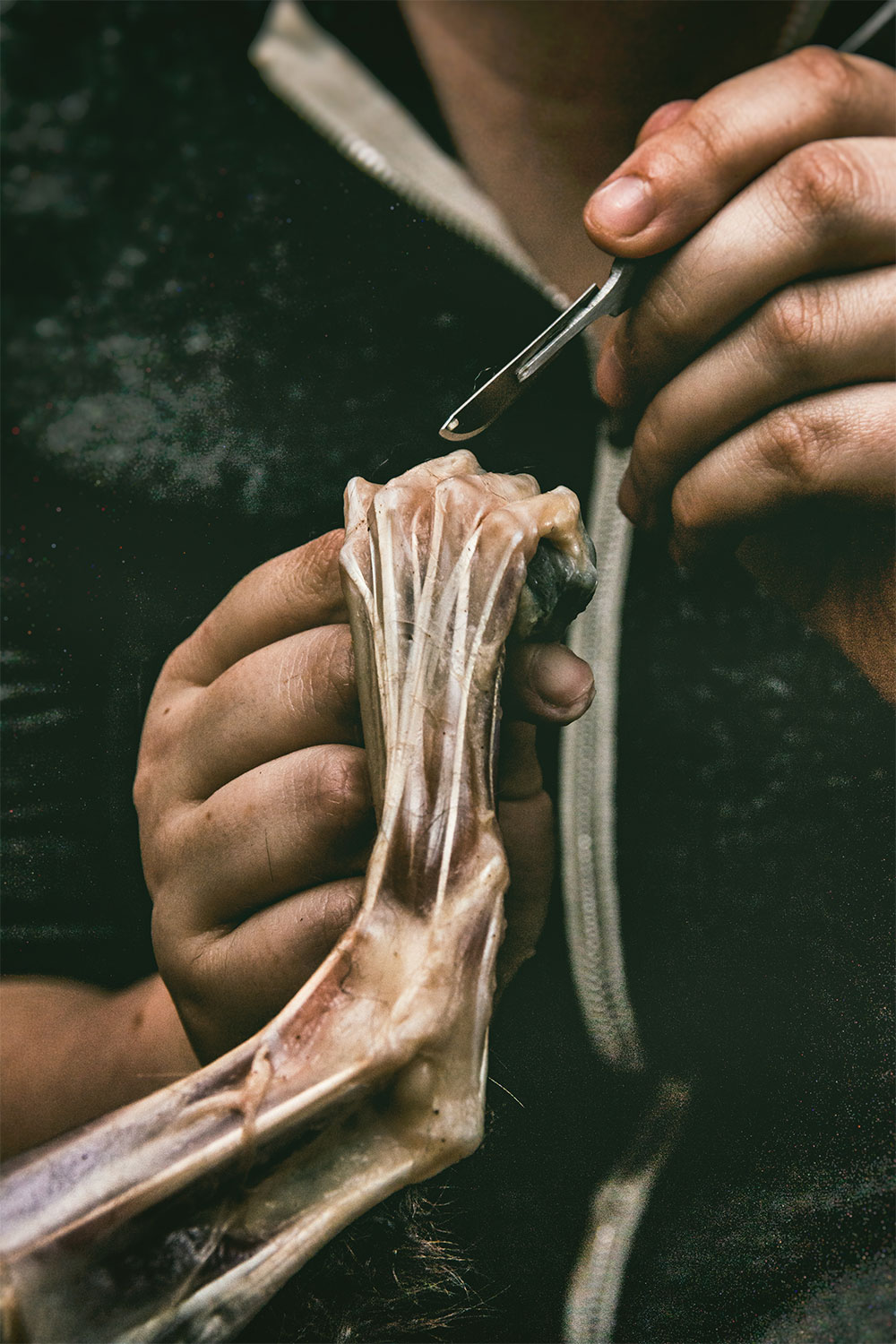
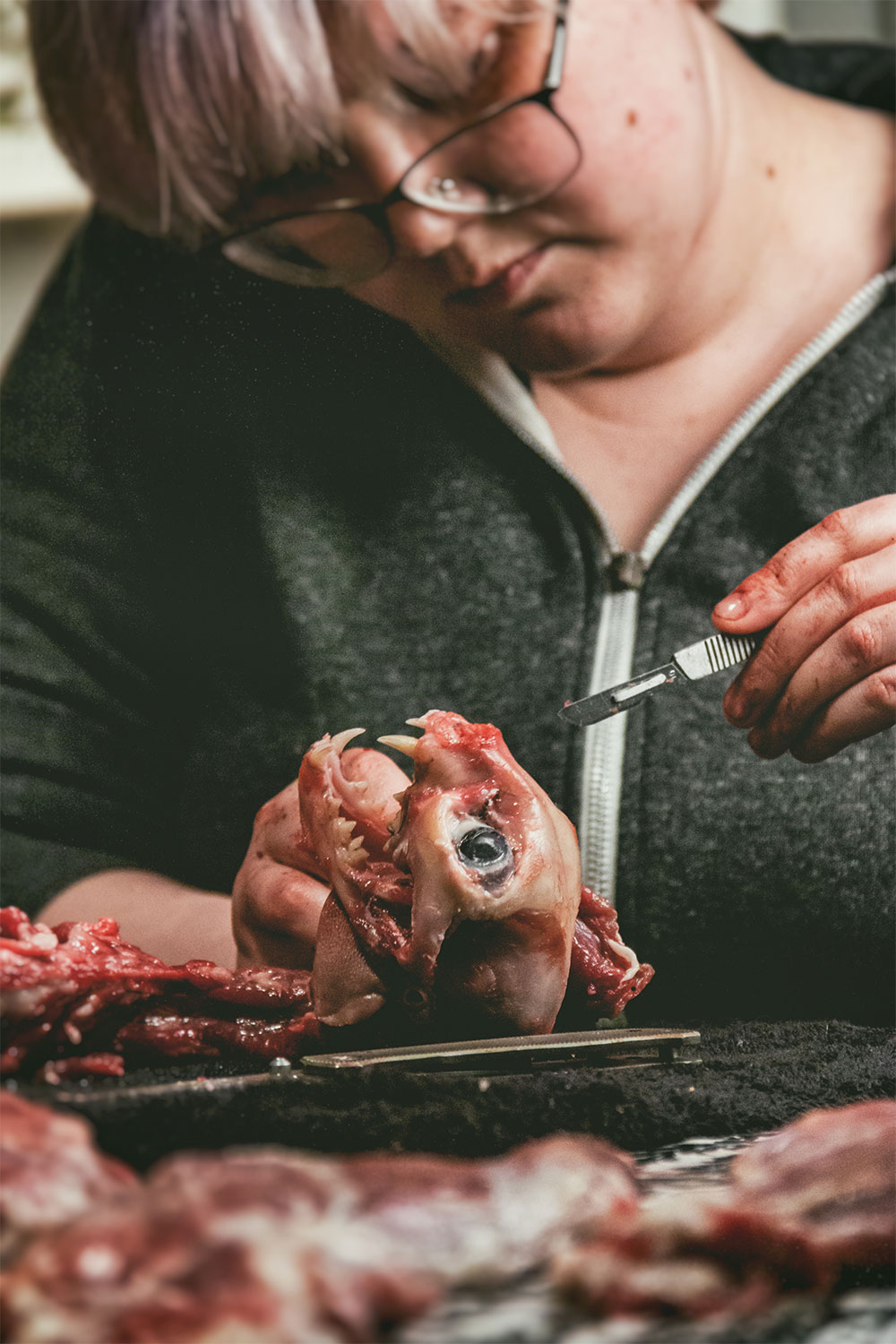
Photos by Photo by Katherine Gaffney
The Bone Collector
Between her junior and senior years in high school, Kinser killed her first and only buck while bow hunting. She decided to have the carcass processed by a taxidermist, but didn’t have the money for it. So she and her mom painted the taxidermist’s house as a trade for his services.
“I saw his shop and everything was in different phases of being processed,” she says. “I was amazed. There was so much artistry and work. It’s such a complex process, and I wanted to know more.”
Throughout college she also worked at Cabela’s, and doing time in customer service at the regional outdoors supplier, with its massive stock of rifles and knives and bows and camouflage, as well as taxidermied animals, kept her tied to her childhood roots. “Hunting, and death in general, has always been kind of lurking in the background of my social life,” Kinser says.
It’s here, precisely, that Kinser’s yearning to make art came into contact with a sentimental attachment to her own childhood, as she began to see the stuff of her past with new eyes. Instead of rebelling against her upbringing, she wondered if the skills and values she learned at the feet of her parents could be translated into something at once personal and aesthetic.
“I had no idea the work that was put into it,” she said of taxidermy. “I wanted to study under somebody, but I didn’t really know who could do that.”
Wanting to mentor with a professional who processed animals into art — a taxidermist or leather-maker, perhaps — she reached out on social media but, she says, she was met with animosity.
“There’s a lot of sexism and a lot of elitism,” Kinser says of that community. “The culture around it is very, very conservative, and very dismissive. They have a very big chip on their shoulder when somebody up-and-coming wants to learn. They basically want to keep the monopoly to themselves.”
So there’s the rub, the challenge: Nothing quite sparks a creative spirit like saying the gulf between past and present can’t be bridged. Kinser took the resistance she met and turned it into inspiration. “My intention is to disrupt that behavior,” she says of her lack of access to the predominantly male culture of taxidermy and animal processing. “I want to be a conduit of change in that aspect of the culture.”
Besides, she says, “my mom’s a painter and I didn’t want to be a copycat.”
Tapping into the knowledge and skills she learned from her father (“I already was pretty decent at butchering and skinning,” she says), Kinser turned her attention to salvaging the already dead and discarded and turning it into art — not mounted big-game heads, but the remains of animals turned into necklaces, artifacts, tokens and still lifes.
“That was a very big value that was ingrained into me from the beginning,” she says, “to not discard things that can be used just because it can be a tricky process to make it usable. A lot of my art is to push people to think what can or can’t be discarded and reused.”
Enlarge
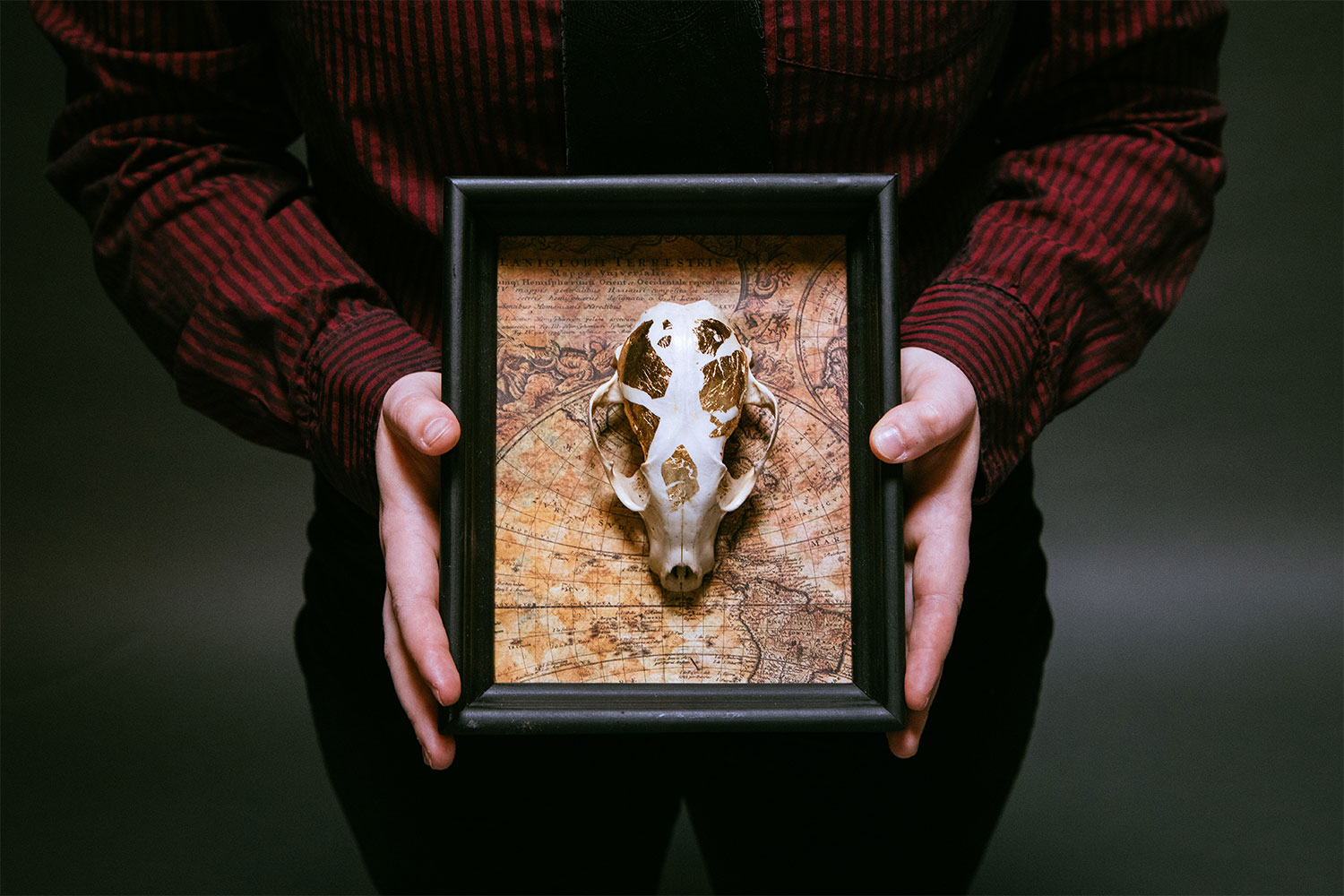
Photo by Todd Cooper
How to Skin a Cat
Tuesday, May 7, 9:17 pm, I get a message from Jessica Kinser: “I took on a pet memorial today. I have him in my freezer and probably won’t be able to start processing him until next week … You want to watch me skin a cat?”
How does one answer such a question? Having put down one of my dearly beloved cats last year, I know what the coward in me answers: No way. I do not want to watch a cat get skinned! It took everything I had to be present when the vet put the needle into my cat’s leg vein, knocking him into deep and irreversible slumber, followed by the killer dose that stopped his heart forever.
Watching my cat die was an impossibly profound experience, heart-rending in its free fall of sorrow and no-take-backs finality, and I will be forever grateful that I faced down my fears in order to see him out. Love conquers all. In a way I can’t quite explain, it was a beautiful experience.
We had his paw prints cast in clay, and that’s all that’s left of Buzz. That, and the memories, which will die with me.
But Kinser had something altogether different in mind with this dead pet. Yes, there would be paw prints, and a nose print, but also a tanned hide, a swatch of fur and a fully articulated skeleton, which the owners would receive as a pet memorial.
Charlie was an 11-year-old Russian blue that actually died in Kinser’s arms after the cat went into shock following a tough surgery. Kinser, who was visiting her friends at the time, attempted CPR, but Charlie was too far gone.
Charlie’s people asked Kinser to do a full pet memorial — which would be her first.
Thursday, May 16, 6:37 pm, message from Kinser: “Charlie is ready…”
Friday, May 17, 4:52 pm, message from Kinser: “I just got home and made some salt dough.”
If I were still a drinking man, I would have taken a couple belts of something strong before I arrived at Kinser’s that Friday.
The small shed behind her house is where Kinser does the majority of the work. In the entryway I pass a small plastic bucket that holds the macerating remains of a baby goat. The smell, when you get your nose up close, can knock you to your knees.
Nothing stinks like death. It takes your breath away.
For the better part of three hours, I watched as Kinser basically turned Charlie inside out, making slow incisions along the legs and torso as she peeled the cat’s skin away from the meat inside. She worked gently but swiftly, with authority, but also with a kind of casual gravity that balanced reverence with acceptance.
There were limpid continents of white fat hiding beneath Charlie’s skin, and the thin tendons that feathered his muscle shone an unearthly silver. Hesitantly, at Kinser’s behest, I touched the fat that swaddled Charlie’s belly, and was surprised at how firmly pliant it felt, like melted cheese half cooled again.
The fur around Charlie’s head — his face, basically — stayed intact until the end, which was disconcerting and oddly sad and touching, like watching a picture fade to its most beautiful point. Several times, Kinser spoke to the cat, softly, urging along the process in consoling tones.
At last, with a newly bladed scalpel, she meticulously removed the connecting tissue around his skull, the snout, the eye sockets, and then the outsides of Charlie were forever separated from the insides. It’s shocking how tiny a cat’s head is.
Enlarge
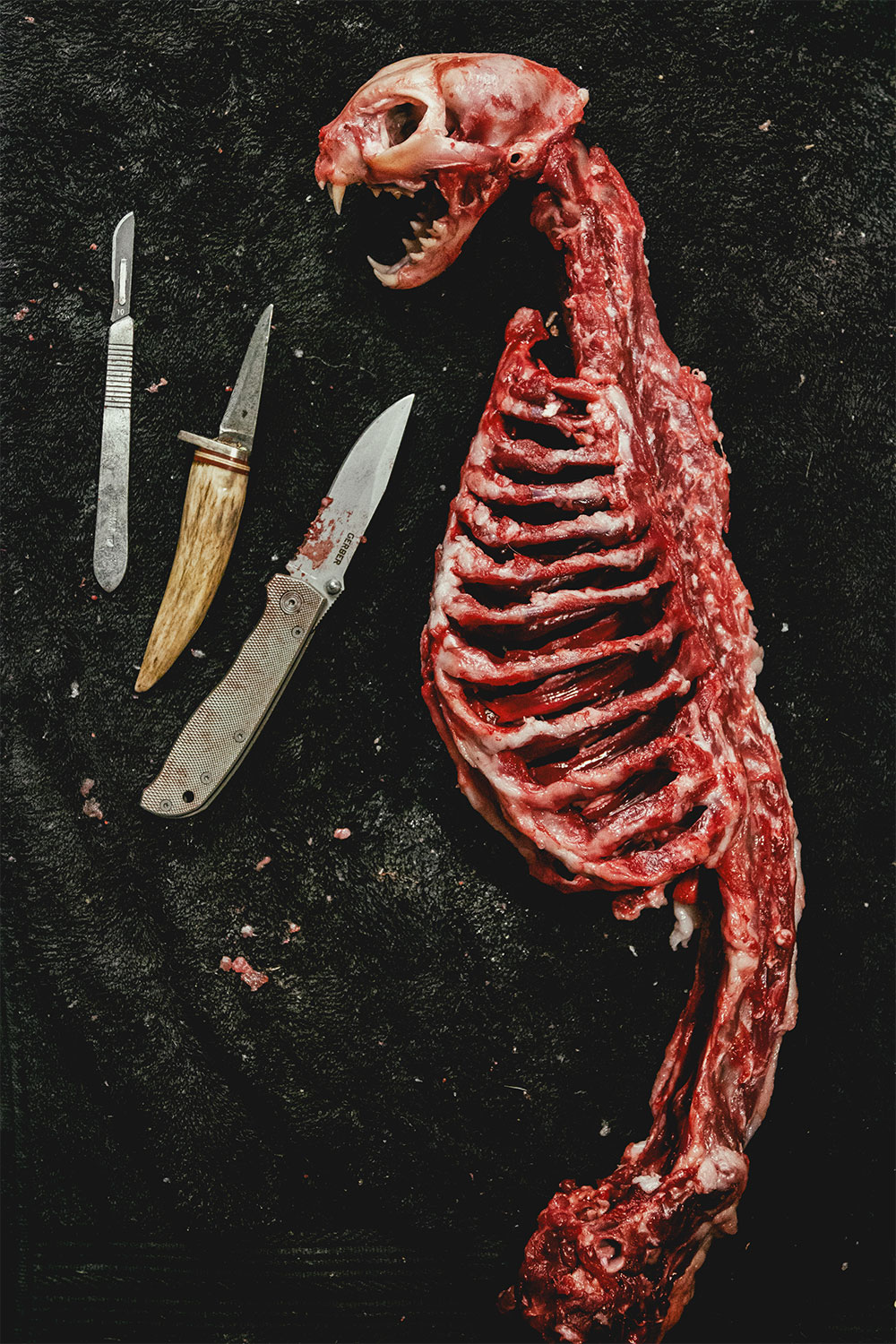
Photo by Katherine Gaffney
From here, Kinser will treat and tan the cat’s hide, carving a heart-shaped patch of fur for the owners as well as providing a base for his reconstructed skeleton. It’s a long process.
“Charlie was actually one of my more emotional ones, because he did die in my arms,” Kinser tells me afterward. “I felt that energy leave, but I also feel like I’m doing him justice, because he died in a traumatic way. Instead of having the end being that traumatic event, she’ll have beautiful artwork to stay in her home. It helps accept that the energy is gone, but you still have these pieces to cling to. It helps make accessing those memories easier.”
Such concerns seem to be at the core of Kinser’s art. An atheist, she seeks to take the sting out of death by restoring it to its place in the cosmic ebb and flow of energy that she considers the foundation of existence.
“I believe in energy,” she says. “I think energy is just trapped in our bodies until our bodies fail, and then the energy moves forward. That energy is transferred.”
In a way, she says, “my spirituality is death. Some of the most spiritual experiences I’ve ever had are finding something dead and making it beautiful. A lot of the taboo around death is because people view it as tragic.”
Her art, then, flies directly in the face of the denial of death that seems to be at the heart of American culture. “It doesn’t need to be tragic,” she says. “It’s inevitable. It’s natural part of the cycle. Maybe the circumstances are tragic, and that’s where I come in. If it makes people uncomfortable, I want to comfort the uncomfortable.”
You can find Jessica Kinser’s art online at Impressions of Decay on Facebook, Instagram and Etsy. She recently participated in the Dark Arts Market at Old Nick’s Pub, and she will be at the Whiteaker Community Market, which runs 11 am to 4 pm every Sunday through September.
